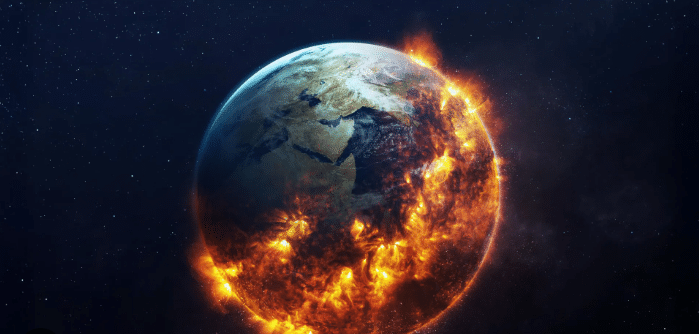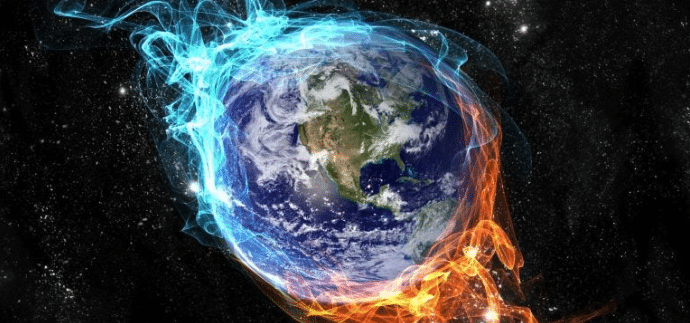Humanity Nears Irreversible Climate Tipping Points: Global Scientists Warn of Cascading System Failures

Meta Description:
The Global Tipping Points Report 2025 warns that Earth is approaching multiple irreversible climate thresholds — from coral reef collapse and melting ice sheets to potential ocean current disruptions. Yet, scientists say hope remains through rapid social and technological transformation.

Introduction
Humanity stands at the edge of a defining moment in planetary history. According to the newly released Global Tipping Points Report 2025 (GTPR 2025), Earth is dangerously close to breaching several irreversible climate thresholds — with some systems, such as tropical coral reefs and parts of the polar ice sheets, already at or beyond their tipping points.
The report, authored by more than 100 international scientists from over 20 countries, paints a stark picture of a world in transition. It warns that the warming trend — driven by human activities and greenhouse gas emissions — could trigger a cascade of interconnected system failures across oceans, forests, and ice sheets. These changes could reshape global weather patterns, raise sea levels by several meters, and alter life on Earth for generations.
Yet, amid these dire warnings, the scientists also identify a glimmer of hope: positive tipping points — rapid, self-reinforcing shifts in human behavior and technology that could accelerate the transition toward sustainability.
The Alarming Findings of the Global Tipping Points Report 2025
A World on the Brink
The 2025 report, released just ahead of the 30th World Climate Conference in Belém, Brazil, outlines the most comprehensive assessment yet of Earth’s “tipping elements” — major natural systems that, once pushed beyond critical thresholds, can trigger irreversible and self-perpetuating change.
Among its most urgent findings:
- Coral reefs across the tropics are collapsing after repeated bleaching events caused by rising ocean temperatures.
- Polar ice sheets in Greenland and West Antarctica may have already entered phases of irreversible melting.
- The Amazon rainforest is approaching a critical point where it could transform into savanna.
- The Atlantic Ocean circulation (AMOC), which regulates climate across Europe and the Americas, faces the risk of collapse — potentially destabilizing global weather systems.
The authors warn that these shifts may not occur in isolation. Instead, they could trigger one another, leading to a domino effect of global climate instability.

Scientists Speak Out: A Call for Urgency
The Warning From Experts
Among the lead authors of the report is Professor Nico Wunderling of Goethe University’s Center for Critical Computational Studies (C3S) in Frankfurt. He co-led the chapter on Earth System Tipping Points and Risks, emphasizing the cascading nature of these phenomena.
“The devastating consequences that arise when climate tipping points are crossed pose a massive threat to our societies,” Wunderling explained. “There is even a risk that tipping in one system could accelerate tipping in others. This risk increases dramatically once we exceed the 1.5°C threshold.”
The coordinating lead author, Professor Tim Lenton of the University of Exeter’s Global Systems Institute, added that surpassing the 1.5°C limit set by the Paris Agreement could initiate multiple irreversible feedback loops — threatening both natural ecosystems and human civilization.
What Are Climate Tipping Points?
Understanding the Concept
Climate tipping points refer to critical thresholds within the Earth’s systems — oceans, forests, ice sheets, and atmospheric patterns — beyond which small changes in temperature can lead to sudden, self-reinforcing, and often irreversible transformations.
The term “tipping point” gained prominence in climate science during the early 2000s, as researchers began identifying components of the planet particularly vulnerable to abrupt change. Once crossed, these thresholds can alter Earth’s climate in ways that persist for centuries or millennia.
Key Examples
- Coral Reefs: Once ocean temperatures exceed 1.2°C above pre-industrial levels, coral bleaching accelerates. Even if global warming stabilizes, reefs may not recover unless temperatures drop back toward 1°C.
- Polar Ice Sheets: Continued melting of Greenland and West Antarctica could lead to sea-level rise of several meters, threatening coastal cities and small island nations.
- Amazon Rainforest: At 1.5–2°C of warming, large portions of the Amazon may convert into savanna, releasing massive amounts of carbon dioxide and intensifying climate change.
- AMOC (Atlantic Meridional Overturning Circulation): This system, which includes the Gulf Stream, helps distribute heat across the Atlantic. Its collapse could plunge parts of Europe into colder winters and disrupt global rainfall patterns.
Coral Reefs at the Breaking Point
The Canary in the Climate Coal Mine
Tropical coral reefs are among the most sensitive ecosystems on Earth. The report concludes that these vibrant underwater ecosystems have likely already passed their thermal tipping point. At current global warming levels of around 1.4°C, reefs have exceeded their survival threshold of approximately 1.2°C.
As a result, vast stretches of coral — from Australia’s Great Barrier Reef to the Caribbean and Indian Ocean — are experiencing mass bleaching events and die-offs. Scientists warn that without dramatic global temperature reductions, most coral ecosystems could vanish within decades.
Why Coral Loss Matters
The disappearance of coral reefs would devastate marine biodiversity. Reefs support 25% of all ocean species and provide food, coastal protection, and livelihoods for over 500 million people worldwide. Their collapse would therefore trigger not only ecological but also economic and humanitarian crises.
Can Coral Reefs Recover?
Recovery is theoretically possible — but only if global temperatures are brought back below 1°C above pre-industrial levels. That would require rapid emission reductions, large-scale carbon removal technologies, and active reef restoration initiatives. Without these measures, most coral species are unlikely to survive this century.

Polar Ice Sheets: Beyond the Point of No Return?
Greenland and Antarctica Under Threat
The GTPR 2025 suggests that some regions of the Greenland and West Antarctic ice sheets may have already crossed their tipping points. The ongoing melt contributes to rising sea levels that could eventually measure in meters, not centimeters.
Greenland’s melting alone could raise sea levels by up to 7 meters over time, while Antarctica could contribute an additional 3–5 meters if critical ice shelves disintegrate. Such levels would permanently submerge coastal megacities like New York, Mumbai, and Shanghai.
The Chain Reaction Effect
As polar ice melts, it exposes darker surfaces (like ocean water or rock) that absorb more sunlight — a phenomenon known as the albedo effect. This accelerates warming, creating a feedback loop that makes further melting inevitable. In turn, this influx of freshwater can disrupt global ocean currents, leading to unpredictable climate shifts.
The Amazon Rainforest: From Carbon Sink to Carbon Source
A Vital Ecosystem Under Siege
The Amazon rainforest plays a crucial role in regulating the global climate. It stores billions of tons of carbon and produces nearly 20% of the world’s oxygen. However, due to deforestation, wildfires, and rising temperatures, this once-stable ecosystem is now teetering on the edge of collapse.
The report estimates that between 1.5°C and 2°C of global warming could push vast parts of the Amazon toward savannization — a transformation into dry grasslands. This shift would release enormous amounts of stored carbon, further amplifying global warming.
A Global Consequence
If the Amazon crosses this threshold, it could accelerate other tipping points, such as monsoon disruptions in South America and Africa. The consequences would ripple far beyond regional boundaries, affecting food security, rainfall distribution, and global biodiversity.
Ocean Circulation in Peril: The AMOC Threat
The Lifeline of Global Climate
The Atlantic Meridional Overturning Circulation (AMOC) — a network of ocean currents that includes the Gulf Stream — acts as a global climate regulator. It transports warm water from the tropics toward the North Atlantic, ensuring mild winters in Europe and stable weather across continents.
The Looming Risk of Collapse
According to the GTPR 2025, the AMOC could collapse at less than 2°C of global warming. Scientists warn that such an event could lead to:
- Sharply colder winters in Western Europe
- Disrupted monsoon systems in Africa, Asia, and South America
- Food production declines due to unpredictable rainfall patterns
- Rising storm intensity and global weather instability
Once the AMOC weakens beyond recovery, the world could face centuries of altered climate behavior.

The Domino Effect: Cascading Climate Failures
One of the most troubling conclusions from the 2025 report is the risk of interconnected tipping points. The failure of one system can accelerate the collapse of others — a phenomenon known as cascading tipping.
For example:
- Melting ice sheets release freshwater, weakening ocean circulation.
- Weakened circulation affects tropical rainfall patterns.
- Reduced rainfall accelerates Amazon dieback.
- Amazon dieback releases CO₂, amplifying global warming.
This chain reaction underscores the urgency of keeping global temperature rise below 1.5°C — the critical limit beyond which system interactions become dangerously unpredictable.
Positive Tipping Points: Reasons for Hope
The Human Factor in Climate Resilience
Despite the dire warnings, the GTPR 2025 also highlights positive tipping points — moments when human innovation and social change accelerate sustainability transitions faster than expected.
Examples include:
- Renewable Energy: Solar and wind power are now cheaper than fossil fuels in most parts of the world.
- Electric Vehicles (EVs): EV adoption is growing exponentially, with major automakers pledging to phase out combustion engines.
- Green Infrastructure: Advances in energy storage, carbon capture, and sustainable building technologies are scaling rapidly.
- Behavioral Change: Growing awareness is driving shifts in diet, transportation, and consumption habits.
Social Contagion and Systemic Change
The report notes that “social contagion” — the spread of sustainable behaviors through peer influence — can trigger massive collective action. Just as negative trends can spread rapidly, so can positive ones. For example, a rise in plant-based diets or community-driven renewable projects can influence entire regions to adopt greener practices.

Policy and Leadership: The Path Forward
Urgent Global Action Needed
The authors call for immediate, coordinated international policies to prevent further warming and safeguard critical ecosystems. They recommend:
- Phasing out fossil fuel subsidies and investing in clean energy
- Strengthening climate adaptation strategies for vulnerable regions
- Protecting and restoring forests, wetlands, and coral ecosystems
- Enhancing carbon pricing and corporate accountability measures
The Role of the 2025 World Climate Conference
The upcoming World Climate Conference in Belém, Brazil, presents an opportunity for nations to reaffirm and strengthen commitments under the Paris Agreement. Scientists urge leaders to focus not just on emission reductions but on preventing tipping cascades and promoting positive tipping momentum through social and economic innovation.
Conclusion: A Critical Decade for Humanity
The Global Tipping Points Report 2025 delivers a stark but clear message: the window to act is rapidly closing. Humanity is now navigating a narrow path between irreversible collapse and transformative recovery.
While coral reefs, ice sheets, and rainforests stand on the edge of catastrophic change, hope remains in the form of human innovation and collective will. The next decade will determine whether our civilization triggers a planetary chain reaction — or sparks a positive tipping point toward a livable, sustainable future.
The choices made today will echo through millennia. As Professor Tim Lenton concluded:
“We are the tipping point generation. Our decisions in this decade will shape the trajectory of Earth’s climate for the next thousand years.”
Suggested Internal Linking for SEO
- Related Article: “The Paris Agreement 2030: Can Global Climate Goals Still Be Achieved?”
- Related Article: “How Renewable Energy is Triggering a Positive Climate Tipping Point”
- Related Article: “The Amazon’s Silent Crisis: Why the Rainforest May Soon Become a Savanna”







